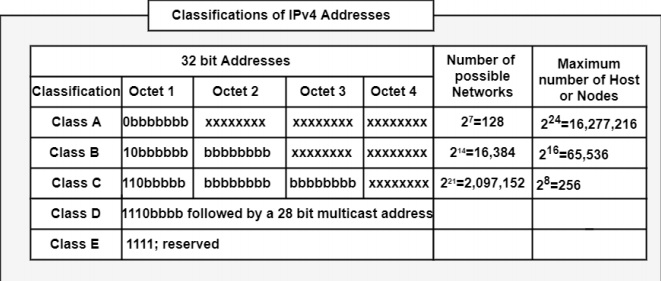
 Data Structure
Data Structure Networking
Networking RDBMS
RDBMS Operating System
Operating System Java
Java MS Excel
MS Excel iOS
iOS HTML
HTML CSS
CSS Android
Android Python
Python C Programming
C Programming C++
C++ C#
C# MongoDB
MongoDB MySQL
MySQL Javascript
Javascript PHP
PHP
- Selected Reading
- UPSC IAS Exams Notes
- Developer's Best Practices
- Questions and Answers
- Effective Resume Writing
- HR Interview Questions
- Computer Glossary
- Who is Who
What are the types of IPv4 Addresses?
IPv4 supports various types of addressing modes which are as follows−
Unicast
It is created to a single network interface located on a specific subnet and facilitates one to-one communication. This is a unique address worldwide for the identification of a machine on the network.
- Subnet prefix: The subnet prefix is a network identifier or network address portion of an IP unicast address. It must be noted that all nodes on the corresponding physical or logical subnet must help the same subnet prefix, which eventually turns into unique within the entire TCP/IP network.
- Host ID: The host ID, a host address area of an IP unicast address. It can identify a network node to which some computers are interfaced.
Multicast
It can be used for one or more network interfaces situated on multiple subnets. It enables one-to-many communication. It delivers individual packets from one source to many destinations. These addresses are elements of Class D addressing design.
Broadcast
It is assigned to all network interfaces located on a subnet and is used for one-to-everyone on a subnet communication. It carries packets from one source to all interfaces on the subnet. Broadcast addresses can be categorized as network broadcast, subnet broadcast, all subnets directed broadcast and definite broadcast.
Internet Addresses are classified into multiple classes. It is based on the number of bits used for the address prefix of a single subnet and the number of bits is used for the host ID. Therefore, it can authorize the number of networks and the multiple hosts per network.
There are five address classes, as follows−
- Class A: It uses an 8-bit network number whose first bit is always zero, as shown in the table. It is reserved for IP unicast addresses. If the number of hosts is huge on a network, this class is used. It uses only one octet to define prefix length. The numbers of the network, which can accommodate, are 28 or 128
- Class B: It facilitates 16 bits for both the network address and host address. The first two bits are continually 10. It is distant from IP unicast addresses. It uses 2 octets for a specific network, while the remaining two octets for host IDs. They are mainly used for medium to large-sized networks. The Class B addresses can be supported to 16,384 networks with up to 65,536 hosts per network.
- Class C: It is distant for IP unicast addresses. They are defined as small networks. The first 3 octets determine a specific network, and the last octet specifies host IDs. The Class C addresses can be used up to 2,097,152 networks with up to 254 hosts per network. Its first three bits are continually set to 110.
- Class D: It defines IP multicast addresses.
- Class E: These addresses were reserved for practical uses.
The Table represents IPv4 addresses classifications.


